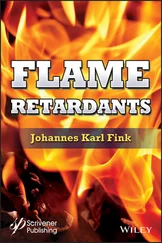Alexander B. MorganDayton, Ohio, USA October, 2021
1
Regulations and Other Developments/Trends/Initiatives Driving Non-Halogenated Flame Retardant Use
Alexander B. Morgan
University of Dayton Research Institute, Center for Flame Retardant Materials Science, Dayton, OH, USA
Abstract
Fire safety of materials is regulated via laws like building codes or product safety laws, which in turn refer to standards of performance and testing needs to meet various fire risk scenarios. As such, fire safety of materials, and the individual components and chemicals involved in these materials are highly regulated. Indeed, as a field of materials science, it is performance needs together with regulatory requirements or voluntary schemes like ecolabels and market trends which drive chemical selection for fire safety needs – in addition to economical constraints. This chapter will discuss the regulatory requirements which affect the choice flame retardant chemicals. Specific regulations of the chemicals themselves, and new regulatory issues that are driving selection and de-selection of specific flame retardant chemicals for fire safety needs will be presented as well.
Keywords:Regulations, codes, standards, fire risk scenarios, fire safety, environment, chemical regulation, politics, ecolabels
1.1 Regulatory History of Halogenated vs. Non-Halogenated Flame Retardants
Before beginning any book on non-halogenated flame retardants, it is important to understand the history of why there is such a book focused on non-halogenated flame retardants. Prior to the late 20 thcentury, flame retardants were not necessarily singled out by any particular chemistry. Indeed, prior to the 1930s, halogen was not used at all as a flame retardant chemical, and even after its discovery and use, it was just another class of chemicals used to impart fire safety to other materials.
To begin with, a flame retardant chemical is a chemical that shows the ability to retard flame growth and spread in a particular material in a particular fire risk scenario. This flame retarding function can be achieved with very diverse chemistries based on the elements bromine, chlorine, phosphorus, nitrogen, and aluminum to name the most prominent. Many of these elements, other than halogen, are discussed throughout this book. On top of these elements, both organic and inorganic substances are being used. The only common feature is that the flame retardant interferes with some of the chemical reactions which are necessary for sustained burning of a material and generally raises the energy that is necessary to ignite a material – flame retardants do not make materials non-combustible.
Not all flame retardants are universally able to flame retard all polymers in all fire risk scenarios. A particular chemical may be very effective in one polymer, but not in another. This is really no different than most chemicals in use throughout the world today: each has its specific chemistry it is capable of, and its own chemical structure-property relationships that yield certain end effects when a chemical reaction occurs. There can be simplicity in grouping chemicals by general structural class and similarity due to how they chemically react. For example, halogenated flame retardants tend to have very similar flame retardant mechanisms of vapor phase combustion inhibition, regardless of chemical structure. There are exceptions where aliphatic and aromatic halogenated compounds can have different reactivity in fire events, as well as additional fuel/chemical interactions that one class will show and the other will not, but some general mechanisms of flame retardancy can be assigned to a group of similar chemicals. As will be discussed, some general classes of flame retardant chemicals include halogenated, phosphorus-based, mineral fillers, nitrogen-based, silicon-based, boron-based, and a wide range of other niche chemicals ranging from transition metal materials to metalloids to carbon-based structures. So while it is possible to group chemicals by flame retardant activity and mechanism, it becomes more complicated to group those same chemicals for reactivity in non-flame retardant scenarios. For example, one mineral filler used as a flame retardant, magnesium hydroxide, works as a flame retardant chemical for wire and cable applications. It also is the active ingredient in “Milk of Magnesia”, which is an oral antacid for heartburn and digestive issues. Other mineral fillers with flame retardant effect may not have this same dual effect and further, may not be safe for ingestion at all. Environmental chemical effects, as well as chemical persistence, bioaccumulation, and toxicity (PBT) profiles are very chemical structure dependent when interacting with humans and the natural environment. All mineral fillers may be persistent (and it is debatable that persistence for minerals is really a problem or not), but they will have very different bioaccumulation and toxicity profiles dependent upon their chemical structure. Likewise, all chemicals and chemical flame retardants will have different PBT profiles, even if they are in the same general chemical class. With this in mind, we can discuss some regulatory history of halogenated vs. non-halogenated flame retardant chemicals.
Halogenated flame retardants began use in earnest in the 1930s and onwards, as they were found to be potent flame retardant additives for flammable materials, as well as strong extinguishing agents such that liquid halogenated solvents were used in fire extinguishers. Indeed, there are reports of fire extinguishing “hand grenades” that were glass globes filled with carbon tetrachloride (now known to be a potent carcinogen) that firemen would lob into fires to help put them out, and, this same halogenated chemical was used in hand-held fire extinguishers [1]. As hazards of these liquid chemicals were found, these liquid halogenated flame retardants were pulled from service and other active extinguishing agents were instead put into fire extinguishers. Halon gas extinguishers were used for severe fire situations, but even these have been pulled from service due to ozone depletion issues. Their relative chemical stability made them non-toxic and therefore a preferred choice, however, for the same reason the chemicals were able to reach the stratosphere where they finally reacted with ozone. Halogenated flame retardant additives put into plastics began to be under regulatory scrutiny in the late 1990s to early 2000s as part of a move to prevent dioxin formation when end-of-life plastics (and other household waste) would be sent to incinerators. Incineration of waste is commonly carried out in Europe due to the lack of landfill space there, and for waste-to-energy efforts that are present in some European countries, especially in Scandinavia. Waste is difficult to presort, and so large amounts of polyvinyl chloride (PVC), as well as other halogenated compounds, ended up in the waste and large amounts of dioxin were formed as part of the emissions from these incineration facilities. As this was discovered, regulations were put in place to mitigate and cease dioxin formation via two methods. The first was with improved emissions capture and cleanup systems (baghouses, scrubbing systems, afterburners), and the second was to remove halogen from the waste stream. The second approach was where regulations against halogenated flame retardants began in earnest, with two well-known directives, the Reduction of Hazardous Substances (RoHS) [2, 3] and Waste Electrical and Electronic Equipment (WEEE) [4, 5]. These initiatives sought to reduce and eliminate the use of halogenated additives in consumer products, namely electronics, which would in turn reduce the amount of halogenated additives going to incinerators, or, accidentally released to the environment. The directives also aim at eliminating legacy brominated flame retardants from recycle streams, so that they do not end up in new E&E equipment via recycling.
Читать дальше












